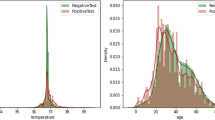Abstract
The goal of this research is to see how well is a fast primary screening method for COVID-19 that relies only on cough sounds collected from 2200 clinically verified samples utilizing the laboratory molecular testing performs (1100 Covid-19 positive and 1100 Covid-19 negative). The clinical labels were applied to the results, and severity of the samples may be judged based on quantitative RT-PCR (qRT-PCR), cycle threshold, and patient lymphocyte counts. The fast spread of the COVID-19 virus poses a significant danger of serious pulmonary disease, and it also causes the most heinous harm to humanity. As a result, a quick and clear disease classification model to distinguish between normal and COVID-19 infected individuals is critical. In this article, we describe the various machine learning and other models that have been used to predict COVID-19 patients.
Access this chapter
Tax calculation will be finalised at checkout
Purchases are for personal use only
Similar content being viewed by others
References
Manne R, Kantheti SC (2021) Application of artificial intelligence in healthcare: chances and challenges. Current J Appl Sci Technol 40(6):78–89. https://doi.org/10.9734/cjast/2021/v40i631320
Khongsai L, Anal TSSC et al (2021) Combating the spread of COVID-19 through community participation. Glob Soc Welf 8:127–132. https://doi.org/10.1007/s40609-020-00174-4
Pandey D, Pandey BK, Wairya S (2021) Hybrid deep neural network with adaptive galactic swarm optimization for text extraction from scene images. Soft Comput 25(2):1563–1580
Kashif M, Javed MK, Pandey D (2020) A surge in cyber-crime during COVID-19. Indo J Social Environ Issues (IJSEI) 1(2):48–52
Pandey D, Ogunmola GA, Enbeyle W, Abdullahi M, Pandey BK, Pramanik S (2021) COVID-19: a framework for effective delivering of online classes during lockdown. Human Arenas 1–15
Singh H, Rehman TB, Gangadhar C, Anand R, Sindhwani N, Babu M (2021) Accuracy detection of coronary artery disease using machine learning algorithms. Appl Nanosci 1–7
Shukla R, Dubey G, Malik P, Sindhwani N, Anand R, Dahiya A, Yadav V (2021) Detecting crop health using machine learning techniques in smart agriculture system. J Sci Ind Res (JSIR) 80(08):699–706
Wang Y, Hu M, Li Q et al (2020) Abnormal respiratory patterns classifier may contribute to large-scale screening of people infected with COVID-19 in an accurate and unobtrusive manner. arXiv:2002.05534
Santosh KC (2019) Speech processing in healthcare: can we integrate? In: Intelligent speech signal processing, pp 1–4. Elsevier
Abeyratne UR, Swarnkar V, Setyati A, Triasih R (2013) Cough sound analysis can rapidly diagnose childhood pneumonia. Ann Biomed Eng 41(11):2448–2462
Manne R, Kantheti S (2020) Coronavirus impact on cardiovascular system of body-review. Int J Res Appl Sci Eng Technol (IJRASET) 8(11):276–280
Bokam Y, Guntupalli C, Gudhanti S, Kulandaivelu U, Alavala R, Alla N, Manne R (2021) Importance of pharmacists as a front line warrior in improving medication compliance in covid 19 patients. Indian J Pharm Sci 83(2):393–396
Sindhwani N, Verma S, Bajaj T, Anand R (2021) Comparative analysis of intelligent driving and safety assistance systems using YOLO and SSD model of deep learning. Int J Inf Syst Model Design (IJISMD) 12(1):131–146
Kamalraj R, Neelakandan S, Kumar MR, Rao VCS, Anand R, Singh H (2021) Interpretable filter based convolutional neural network (IF-CNN) for glucose prediction and classification using PD-SS algorithm. Measurement 183:109804
Kassaw C, Pandey D (2021) The current mental health crisis of COVID-19 pandemic among communities living in Gedeo Zone Dilla, SNNP, Ethiopia, April 2020. J Psychosoc Rehabil Mental Health 8(1):5–9
Pandey D, Islam T, Magray JA, Gulzar A, Zargar SA (2021) Use of statistical analysis to monitor novel coronavirus-19 cases in Jammu and Kashmir, India. Eur J Biol Res 11(3):274–282
Parthiban K, Pandey D, Pandey BK (2021) Impact of SARS-CoV-2 in online education, predicting and contrasting mental stress of young students: a machine learning approach. Augmented Hum Res 6(1):1–7
Ayenew B, Pandey D, Yitayew M, Etana D, Binay Kumar P, Verma N (2020) Risk for surge maternal mortality and morbidity during the ongoing corona virus pandemic. Med Life Clin 2(1):1012
Meivel S, Sindhwani N, Anand R, Pandey D, Alnuaim AA, Altheneyan AS, ... and Lelisho ME (2022) Mask detection and social distance identification using internet of things and faster R-CNN algorithm. Comput Intell Neurosci
Radwan E, Radwan A, Radwan W, Pandey D (2021) Prevalence of depression, anxiety and stress during the COVID-19 pandemic: a cross-sectional study among Palestinian students (10–18 years). BMC Psychol 9(1):1–12
Author information
Authors and Affiliations
Corresponding author
Editor information
Editors and Affiliations
Rights and permissions
Copyright information
© 2023 The Author(s), under exclusive license to Springer Nature Singapore Pte Ltd.
About this paper
Cite this paper
Singh, H. et al. (2023). Effective Overview of Different ML Models Used for Prediction of COVID-19 Patients. In: Gupta, M., Ghatak, S., Gupta, A., Mukherjee, A.L. (eds) Artificial Intelligence on Medical Data. Lecture Notes in Computational Vision and Biomechanics, vol 37. Springer, Singapore. https://doi.org/10.1007/978-981-19-0151-5_15
Download citation
DOI: https://doi.org/10.1007/978-981-19-0151-5_15
Published:
Publisher Name: Springer, Singapore
Print ISBN: 978-981-19-0150-8
Online ISBN: 978-981-19-0151-5
eBook Packages: EngineeringEngineering (R0)




